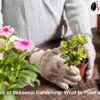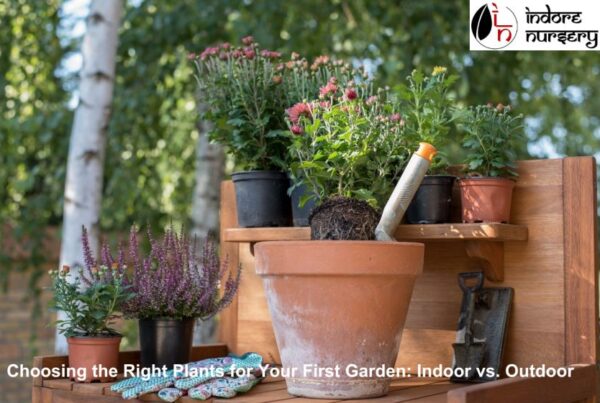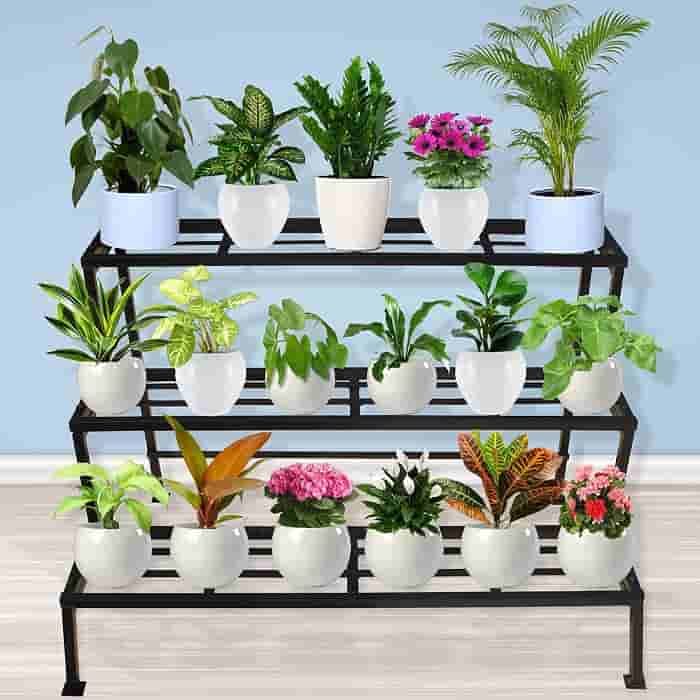Embracing the green oasis of indoor plants has become a sensational trend, injecting life and freshness into our homes. But the joy of plant parenthood, one question persists: How much and how often should we water our beloved indoor plants?
In this modern and engaging guide, we will demystify the art of watering indoor plants, equipping you with the latest insights and expert tips to nurture your leafy companions with confidence.
What are you waiting for, Christmas? Let’s start reading it!
The Fundamentals Of Indoor Plant Watering
An essential component of caring for indoor plants is proper watering. Understanding the basics of indoor plant watering is essential for the health and vitality of your leafy companions. Water serves as a lifeline for plants, providing hydration, and nutrients, and facilitating crucial physiological processes. However, striking the right balance is key, as overwatering or underwatering can have detrimental effects.
In this section, we will focus on the fundamentals of indoor plant watering, equipping you with the knowledge and guidelines to ensure optimal hydration for your indoor plants.
The Role Of Water In Plant Health
Water plays a vital role in the overall health and well-being of not only our bodies but indoor plants as well. It serves as a transportation system, carrying essential nutrients from the soil to various parts of the plant.
Additionally, water enables photosynthesis, the process by which plants convert light energy into chemical energy to fuel growth. Adequate water uptake ensures turgidity, supporting the plant’s structure and preventing wilting.
Furthermore, water helps regulate temperature through transpiration, where excess water evaporates through the plant’s leaves, cooling the plant in the process. Overall, water is an indispensable resource that sustains plant life.
Factors Influencing Watering Needs
Several factors influence the watering needs of indoor plants. Understanding these factors will help you tailor your watering routine to the specific requirements of each plant. Consider the following factors:
- Light Intensity And Duration: Plants exposed to bright light generally have higher water needs than those in lower light conditions.
- Humidity Levels: High humidity reduces water loss through transpiration, affecting the frequency of watering.
- Potting Medium And Drainage: The type of potting mix and the presence of drainage holes impact water retention and drainage, affecting watering frequency.
- Plant Types And Their Watering Needs: Different plant species have varying water requirements. Succulents, for instance, tolerate drought conditions and require infrequent watering, while tropical plants often prefer consistently moist soil.
Signs Of Overwatering And Underwatering
Overwatering and underwatering can have detrimental effects on indoor plants. It’s crucial to recognize the signs of both to adjust your watering practices accordingly.
Signs of overwatering include yellowing leaves, wilting, root rot, and a damp or musty smell from the soil. On the other hand, under-watered plants may exhibit wilted, dry, or crispy leaves, as well as slow growth.
Establishing A Consistent Watering Routine
When it comes to watering indoor plants, consistency is essential. Establishing a regular watering routine helps provide stability and prevents fluctuations in soil moisture. Consider factors such as the plant’s water needs, environmental conditions, and potting medium to determine the appropriate frequency of watering.
In the next sections, we will explore advanced techniques, tools, and considerations to help you become an expert in watering your indoor plants. Stay tuned to learn more about determining the right amount of water, mastering watering techniques, and troubleshooting common watering issues. Remember, mastering the fundamentals is the first step towards nurturing healthy, thriving indoor plants.
Cutting-Edge Watering Techniques And Best Practices
Mastering cutting-edge watering techniques and adopting best practices can elevate your indoor plant care to the next level. In this section, we will explore advanced techniques, innovative tools, and essential considerations to help you optimise your watering routine and ensure the well-being of your indoor plants.
Determining The Right Amount Of Water
Accurately determining the appropriate amount of water for your indoor plants is crucial. Consider the following techniques:
- The Finger Test: Insert your finger into the soil up to your knuckle. It’s time to water if the top inch of the soil feels dry. If it feels moist, hold off on watering.
- Moisture Metres: Utilise moisture metres, which provide precise readings of soil moisture levels. These handy devices take the guesswork out of watering and help you determine when your plants need hydration.
- Weighing Method: Pick up your potted plant and get a sense of its weight when the soil is dry. Water it thoroughly, and then lift it periodically to gauge its weight. When the pot feels significantly lighter, it’s time to water again.
- Plant-Specific Needs: Different plants have different water requirements. Research the specific needs of each plant in your collection and adjust your watering practices accordingly.
Next-Level Watering Tools And Gadgets
Upgrade your watering arsenal with these innovative tools and gadgets:
- Self-Watering Pots: These pots feature a reservoir that provides a constant supply of water to the plant, ensuring consistent moisture levels and reducing the risk of overwatering.
- Watering Wands: Long, narrow watering wands with a gentle shower head attachment allow for precise watering without disturbing delicate foliage.
- Capillary Mats: These mats wick water from a reservoir beneath the pots, supplying a steady and controlled amount of moisture to the plants.
- Hydrogel Crystals: These water-absorbing crystals can be mixed into the potting mix to improve moisture retention and reduce the frequency of watering.
Revolutionising Watering Methods
Explore alternative watering methods to provide optimal hydration for your indoor plants:
- Top-Down Watering: Mimic rainfall by watering the soil surface from above. This method allows water to penetrate deeply and encourages robust root growth.
- Bottom-Up Watering: Place your potted plants in a tray or basin filled with water. The plants will absorb the water from the drainage holes, ensuring thorough hydration.
- Drenching Or Soaking: Occasionally, thoroughly soak the potting mix to flush out accumulated salts and promote better nutrient uptake. Allow excess water to drain completely.
Water Quality And Temperature Considerations
Water quality and temperature play vital roles in indoor plant watering:
- Water Quality: Use room temperature tap water or allow chlorinated water to sit for 24 hours before watering. Alternatively, consider using filtered or rainwater, particularly for sensitive plants.
- Water Temperature: Avoid using water that is too cold or too hot. Use water at room temperature to prevent shocking the plant’s roots.
Unlocking The Watering Frequency Formula
Determining the ideal watering frequency depends on various factors:
- Seasonal Variations: Adjust your watering routine based on seasonal changes in temperature, light levels, and humidity. Plants generally require less water during winter when growth slows down.
- Adapting To Plant Growth Cycles: Consider the growth stage of your plants. Young and actively growing plants often require more frequent watering compared to mature and dormant ones.
By embracing these cutting-edge techniques and adopting best practices, you can fine-tune your watering routine and provide optimal hydration for your indoor plants.
We have already mentioned above some of the influential factors in indoor plant watering. Let’s watch out for them in detail.
Influential Factors In Indoor Plant Watering
When it comes to watering indoor plants, several influential factors should be taken into account to ensure the health and well-being of your leafy companions. Understanding these factors will help you tailor your watering routine to meet the specific needs of your plants. Let’s explore some of the most influential factors in indoor plant watering:
Lighting Conditions
The intensity and duration of light exposure directly impact a plant’s water requirements. Plants exposed to bright, direct sunlight tend to lose water more rapidly through transpiration and may require more frequent watering. On the other hand, plants in low-light conditions typically have lower water needs as they have reduced transpiration rates.
Humidity Levels
Humidity levels in your indoor environment also affect the water requirements of your plants. High humidity reduces the rate of water loss through transpiration, resulting in lower water needs. Conversely, plants in drier environments may require more frequent watering to compensate for the increased evaporation.
Potting Medium And Drainage
The type of potting medium and its drainage capacity plays a significant role in indoor plant watering. Well-draining potting mixes allow excess water to flow through the soil, preventing waterlogging and the risk of root rot. On the other hand, heavier or water-retentive potting mixes may require less frequent watering as they hold onto moisture for longer periods.
Plant Types And Watering Needs
Different plant species have varying water requirements. Understanding the specific needs of your plants is crucial to avoid overwatering or underwatering. For example, succulents and cacti are adapted to arid environments and prefer infrequent watering, while tropical plants thrive in consistently moist soil and may require more frequent watering.
Plant Size And Growth Stage
The size and growth stage of your indoor plants also influences their water requirements. Smaller plants and those in the early stages of growth typically have shallow root systems and may require less water compared to larger, more established plants with extensive root systems. Adjust your watering frequency accordingly based on the size and growth stage of each plant.
Environmental Factors
Environmental factors such as temperature, airflow, and indoor heating/cooling systems can affect the rate of water loss through evaporation and transpiration. Higher temperatures and increased airflow can lead to faster water loss, necessitating more frequent watering. Likewise, heating or cooling systems can affect the overall humidity levels in your indoor environment and impact plant water needs.
Seasonal Variations
Seasonal changes can also influence indoor plant watering requirements. During the warmer months or growing seasons, plants tend to have increased water needs due to higher temperatures and increased growth rates. Conversely, during winter or dormancy periods, plants generally require less water as their growth slows down.
By considering these influential factors, you can develop a customised watering routine that meets the specific needs of your indoor plants. Remember to monitor your plants closely, adjust watering as needed, and always prioritise proper drainage to ensure optimal plant health and vitality.
Troubleshooting Watering Woes
While watering indoor plants is essential for their health, it’s common to encounter watering woes along the way. Fortunately, most watering issues can be resolved with a bit of troubleshooting. Let’s explore some common watering problems and their solutions:
Overwatering
A frequent error that can result in root rot and other plant health problems is overwatering. Signs of overwatering include yellowing leaves, wilting, a damp or musty smell from the soil, and waterlogged soil.
Solution:
- Before watering again, let the soil dry out. Stick to a consistent watering schedule and avoid watering if the soil is still moist.
- Ensure proper drainage by using pots with drainage holes and saucers to catch excess water. Empty the saucers after watering to prevent plants from sitting in standing water.
- Adjust your watering frequency based on environmental factors such as temperature and humidity levels.
- Look for indications of root rot in the root system. If severe, consider repotting the plant in fresh, well-draining soil.
Underwatering
Underwatering occurs when plants don’t receive enough water, leading to wilting, dry or crispy leaves, and slow growth.
Solution:
- Regularly check the soil’s moisture content, and water when the top inch seems parched.
- Ensure thorough watering by watering until water flows through the drainage holes, ensuring the entire root ball is adequately hydrated.
- Consider increasing humidity levels around the plant by misting the leaves or placing a tray of water nearby.
- When plants are grouped, a microclimate with increased humidity levels can be produced.
Inconsistent Watering
Inconsistent watering, where plants receive irregular amounts of water, can lead to stress and health issues for your indoor plants.
Solution:
- Establish a consistent watering schedule based on the specific needs of each plant. Consider factors such as light intensity, humidity levels, and the plant’s water requirements.
- Use tools such as moisture metres or the finger test to ensure that you’re watering constantly and not letting the soil become too dry or waterlogged.
- Consider using self-watering pots or other watering aids that can help maintain more consistent moisture levels in the soil.
Water Quality Issues
Water quality can also affect plant health. Chlorinated tap water or water high in salts or minerals can lead to leaf burn, browning of leaf tips, or stunted growth.
Solution:
- Allow tap water to sit for 24 hours before watering to allow chlorine to evaporate.
- Consider using filtered or distilled water, especially for sensitive plants.
- Periodically flush the soil with fresh, clean water to help leach out any excess salts or minerals.
Adjusting To Changing Seasons
Seasonal changes in temperature and light levels can impact watering needs. Failure to adjust watering routines accordingly can lead to overwatering or underwatering.
Solution:
- Monitor your plants closely during seasonal transitions and adjust the watering frequency as needed.
- Consider factors such as temperature, humidity, and light levels when determining the appropriate watering routine.
- Be mindful that plants may require less water during the dormant or winter months.
By troubleshooting and addressing these common watering woes, you can help your indoor plants thrive. Remember to observe your plants closely, make adjustments as needed, and always prioritise the specific needs of each plant. With a little care and attention, you’ll develop a watering routine that promotes the health and vitality of your indoor greenery.
Conclusion
With this trendy and cutting-edge guide of care tips, you now hold the key to expertly watering your indoor plants. By understanding the fundamentals, implementing the latest techniques, and adapting to the unique needs of your leafy friends, you can ensure their well-being and witness the flourishing beauty they bring to your living spaces.
Remember, a happy and hydrated plant is a sight to behold, and with your newfound knowledge, you’re ready to embrace the art of watering with finesse.










Recent Comments